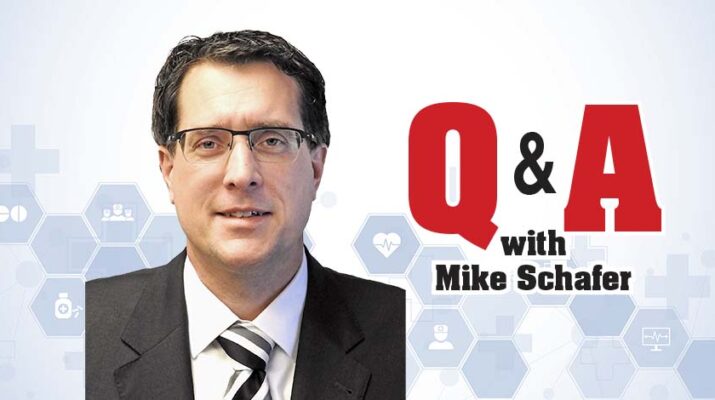St. Camillus’ new president and CEO talks about the challenges nursing homes face today, sees less dependency on skilled nursing facilities in the future
By Mary Beth Roach
Michael Schafer was named CEO and president of St. Camillus in December 2022, having served as former VP for the St. Camillus Nursing Facility for 11 years. Nearly a year into the job, Schafer discusses his work and the ever-changing skilled nursing care.
Q: To give our readers an idea of the size of St. Camillus, what levels of care are provided, how many patients are in your care, how many employees do you have, and what is your budget?
A: Currently our operating budget is approximately $35 million for this year and obviously, with inflation, it will be increased moderately as we turn into ’24. St. Camillus currently has 352 staff. In addition, we have both agency and contracted staff that brings the total to about 450. Our bed capacity is 284. We’ve been averaging about 87% year-to-date now.
Q: As CEO and president, what are some of your responsibilities, challenges and rewards?
A: One of the big things that health care is challenged with across the board — from acute all the way through the private practices — is the financial stability and long-term viability, so continuing to take a look at the operations from a financial perspective; seeing where some of those controls can be put in place; the provision of quality care and services; regulatory compliance; workforce stability, which is obviously another big one in our healthcare industry today; overall strategic direction to see how you revision the organization and what direction you need to go in.
Some of the challenges, all the inflationary pressures; the healthcare workforce challenges; supply-and-demand continues to be a big one across all sectors of healthcare; the ongoing regulatory requirements; and infection control challenges, how organizations have to realign to put those appropriate measures in place to continue to be on a positive front as it relates to managing COVID-19.
Q: How about rewards?
A: Some rewards, continuing to work with a dedicated and committed board. Because we’re a not-for-profit, we have a board of trustees and members. It’s rewarding to be able to work with them and get their support; continuing to work with our dedicated and committed staff, who are ultimately the ones driving the organization; achieving our star rating. The federal government set forth a star rating, and we achieved the highest star rating earlier this year, which is a five-star rating. It’s based on survey results, quality metrics and staffing. We’re one of a few facilities in Onondaga County that has achieved the five-star rating. That’s a direct reflection of our quality team, as well as all of our staff in multiple departments that continue to drive those metrics.
About the organization, we have one of the only certified brain injury units in the state. We offer short-term rehabilitation, skilled nursing, and some transportation. We bring in many of our new admissions, which makes things more streamlined for the hospitals upon discharge. A lot of our residents, short-term and long-term, have appointments that they need to go to outside provider specialists and that is offset significantly by our team.
Q: Nursing home care is a field that seems to be constantly changing. What do you see for the future of nursing home care, and more specifically, St. Camillus?
A: Skilled nursing facilities will continue to experience an increase in the shift of patients transitioning to home and community-based programs, resulting in a potential decreased dependency on skilled nursing facilities. St Camillus has an ongoing commitment to enhance our clinical capabilities and programs to accommodate more clinically complex referrals to align with hospital and community needs.
We are going to continue to develop further specialty programs, working with other key stakeholders to continue to leverage their expertise and experience; continue to leverage technology. We all know the benefits of harnessing that technology can help with the provision of care and services. I think payment models are going to continue to change. They’re going to be more value-based on outcomes and it’s going to be interesting to see how that ultimately plays out. Workforce will continue to be a key focus, something that we will continue to invest a lot of time and energy, working and enhancing our culture to continue to have satisfied workers. In an organization like ours, the success is predicated on our team, an engaged team. We’ll continue to drive that experience for patients.
Q: What would you like to see there in the next year or two?
A: We’ve been a recipient of a $6.4 million grant. So successfully implementing that grant, which basically equates to a significant amount of capital improvements. We’re really trying to enhance the home-like environment for our patients and residents we serve, looking at continuing to try to drive our occupancy from a financial perspective, and really focusing a significant amount of time and energy on our workforce to continue to try to enhance that culture.

